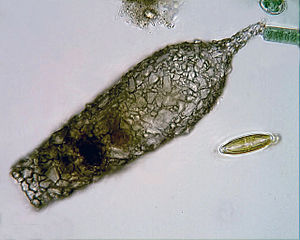Testate amoebae: Difference between revisions
mNo edit summary |
No edit summary |
||
| Line 1: | Line 1: | ||
=== | ===Overview & Significance=== | ||
'''Testate amoebae''' (Testacea, or Hyalosphenia) are amoeboid protists, differing from [[naked amoebae]] in that they inhabit a test, or shell. The '''test''' of the testate can be created entirely by the amoeba, in which it would create an organic, siliceous, or calcareous shell depending on the species of testate amoeba. These tests created entirely by the amoeba are known as '''autogenic tests''', as seen in | '''Testate amoebae''' (Testacea, or Hyalosphenia) are amoeboid protists, differing from [[naked amoebae]] in that they inhabit a test, or shell. The '''test''' of the testate can be created entirely by the amoeba, in which it would create an organic, siliceous, or calcareous shell depending on the species of testate amoeba. These tests created entirely by the amoeba are known as '''autogenic tests''', as seen in Figure 1. An '''xenogenic test''' is made up of particles of sediment collected by the amoeba which are then agglutinated together by secretions within the cell, as seen in Figure 2. | ||
[[File: Arcella_discoides.jpg|thumb|300x300px|Figure 1: the ''autogenic'' test of Arcella discoides, made up of organic plates..]] | [[File: Arcella_discoides.jpg|thumb|300x300px|Figure 1: the ''autogenic'' test of Arcella discoides, made up of organic plates..]] | ||
[[File:Difflugia_acuminata.jpg|thumb|300x300px|Figure 2: An ''xenogenic test'' of a Difflugia acuminata. Depicts an agglutinated test made up of mineral particles glued together with secretions from within the cell.]] | [[File:Difflugia_acuminata.jpg|thumb|300x300px|Figure 2: An ''xenogenic test'' of a Difflugia acuminata. Depicts an agglutinated test made up of mineral particles glued together with secretions from within the cell.]] | ||
The shells which these protozoa develop are able to be preserved long after the amoeba has died. This characteristic combined with Testacea sensitivity to environmental factors, such as pH, temperature, etc., has shown their usefulness as bioindicators and paleoclimate proxies. | |||
===Habitat=== | ===Habitat=== | ||
This group of free-living microorganisms inhabit aquatic to moist habitats including: estuaries, lakes, rivers, wetlands, soils, litter, and moss habitats. They are able to live in both fresh and marine water, however, compared to naked amoeba, testate amoebae are less abundant in most soils. | This group of free-living microorganisms inhabit aquatic to moist habitats including: estuaries, lakes, rivers, wetlands, soils, litter, and moss habitats. They are able to live in both fresh and marine water, however, compared to naked amoeba, testate amoebae are less abundant in most soils. | ||
| Line 11: | Line 9: | ||
===References=== | ===References=== | ||
[1] Coleman, D.J., Callaham, M. A., Jr., Crossley, D.A.. November 2017. 'The Fundamentals of Soil Ecology'. Third Edition. Elsevier Academic Press. | |||
and | [2] Louiser, J.D., Parkinson, S.S.. 1981. 'Evaluation of a membrane filter technique to count soil and litter Testacea'. Soil Biol. Biochem. 13. 209-2013 | ||
[3] Mitchell, Edward A. D.; Charman, Daniel J.; Warner, Barry G. 2008. "Testate amoebae analysis in ecological and paleoecological studies of wetlands: past, present and future" (PDF). Biodiversity and Conservation. 17 (9): 2115–2137. doi:10.1007/s10531-007-9221-3. ISSN 0960-3115. | |||
Revision as of 17:03, 23 April 2021
Overview & Significance
Testate amoebae (Testacea, or Hyalosphenia) are amoeboid protists, differing from naked amoebae in that they inhabit a test, or shell. The test of the testate can be created entirely by the amoeba, in which it would create an organic, siliceous, or calcareous shell depending on the species of testate amoeba. These tests created entirely by the amoeba are known as autogenic tests, as seen in Figure 1. An xenogenic test is made up of particles of sediment collected by the amoeba which are then agglutinated together by secretions within the cell, as seen in Figure 2.


The shells which these protozoa develop are able to be preserved long after the amoeba has died. This characteristic combined with Testacea sensitivity to environmental factors, such as pH, temperature, etc., has shown their usefulness as bioindicators and paleoclimate proxies.
Habitat
This group of free-living microorganisms inhabit aquatic to moist habitats including: estuaries, lakes, rivers, wetlands, soils, litter, and moss habitats. They are able to live in both fresh and marine water, however, compared to naked amoeba, testate amoebae are less abundant in most soils. They thrive in soil environments that are moist and within forested systems.
References
[1] Coleman, D.J., Callaham, M. A., Jr., Crossley, D.A.. November 2017. 'The Fundamentals of Soil Ecology'. Third Edition. Elsevier Academic Press. [2] Louiser, J.D., Parkinson, S.S.. 1981. 'Evaluation of a membrane filter technique to count soil and litter Testacea'. Soil Biol. Biochem. 13. 209-2013 [3] Mitchell, Edward A. D.; Charman, Daniel J.; Warner, Barry G. 2008. "Testate amoebae analysis in ecological and paleoecological studies of wetlands: past, present and future" (PDF). Biodiversity and Conservation. 17 (9): 2115–2137. doi:10.1007/s10531-007-9221-3. ISSN 0960-3115.